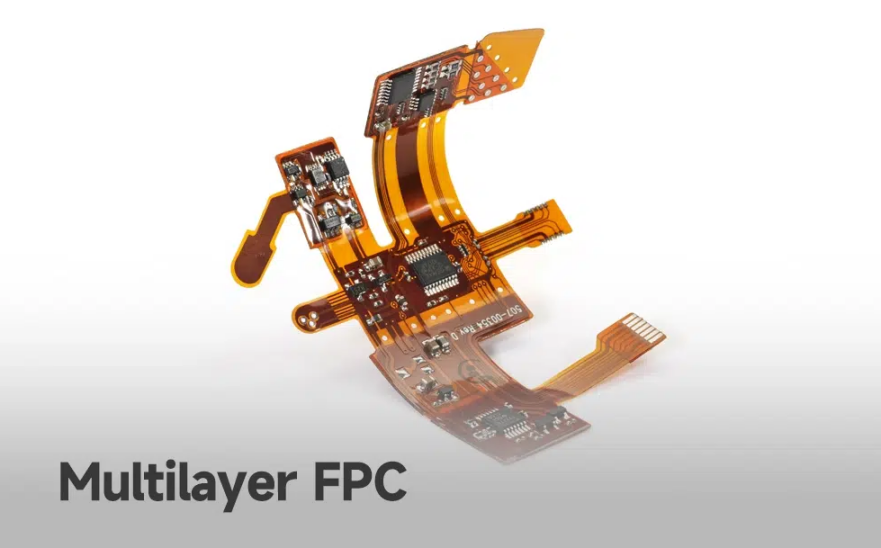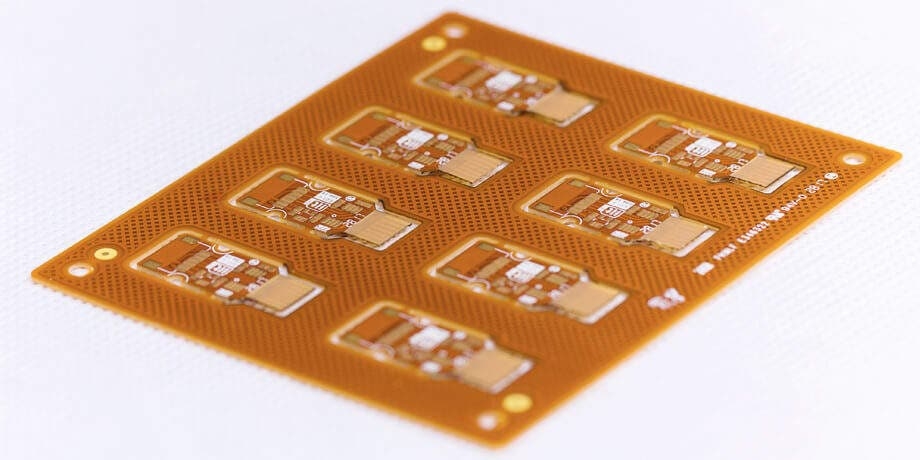Multilayer flexible PCBs play a crucial role in modern electronics, featuring three or more flexible conductive layers insulated by polyimide layers. These circuits utilize metalized vias and plating to effectively transmit signals between layers. Their flexibility and lightweight construction cater to applications requiring compact and adaptable electronic solutions. Widely used in consumer electronics, medical devices, and aerospace technology, multilayer flexible PCBs seamlessly integrate complex functionalities in restricted environments, ensuring dependable performance and bolstering product longevity and efficiency.

Understanding Multilayer Flexible PCBs
Definition and Structure of Multilayer Flexible PCBs
Multilayer flexible PCBs, also known as flex circuits, feature three or more conductive layers separated by flexible insulating materials, typically polyimide. These layers are interconnected using metalized vias, facilitating electrical connections while maintaining the PCB's flexibility. External layers are also polyimide, ensuring strong insulation and protection.
Advantages over Rigid PCBs
Multilayer flexible PCBs offer significant advantages over rigid counterparts. They are lightweight and can be folded or bent to fit into tight spaces, making them ideal for compact electronic devices. Their flexibility reduces the need for connectors and wiring, simplifying assembly and lowering potential failure points. Moreover, they withstand vibrations and mechanical stress better than rigid PCBs, enhancing reliability in dynamic environments.
Materials Used in Multilayer Flexible PCBs
Key materials in multilayer flexible PCBs include polyimide for the substrate and outer layers, providing thermal stability, chemical resistance, and flexibility. Copper is preferred for conductive layers due to its high conductivity and suitability for via plating. Adhesive materials ensure robust bonding between layers, maintaining structural integrity and electrical connectivity.
Best FPC's Design Innovations in Multilayer Flexible PCBs
Miniaturization Trends and Challenges
The demand for multilayer flexible PCBs (FPCs) capable of supporting miniaturization continues to rise as electronic devices shrink in size. These PCBs must deliver high performance while fitting into increasingly smaller spaces. Challenges include preserving signal integrity and managing thermal dissipation in densely packed configurations. Achieving ultra-fine features like minimum line width and spacing of 4 mils poses technical hurdles that drive material innovation and precise fabrication techniques. Multilayer flexible PCBs are pivotal in advancing modern electronics due to their ability to meet these stringent requirements.
Advanced Fabrication Techniques for High-Density Interconnects
Advanced fabrication techniques are essential for integrating complex circuit designs into compact spaces with high-density interconnects (HDIs). Modern multilayer flexible PCBs feature three to over fourteen layers, using plated through-holes (PTH) and advanced lamination processes for sophisticated inter-layer connections. These PCBs utilize adhesive-based and adhesiveless constructions to enhance mechanical and thermal stability, incorporating materials such as thermoplastic and thermoset stiffeners to maintain structural integrity under mechanical stress. Innovations like screened inks and photo-imageable soldermasks support intricate circuit patterning, crucial for achieving reliable connectivity and functionality in confined layouts.
EMI Shielding and Material Innovations
Electromagnetic interference (EMI) shielding remains critical in designing multilayer flexible PCBs to ensure uninterrupted device performance. Material advancements play a pivotal role, with polyimide substrates ranging from 1/2 mil to 4 mils thick and copper layers from 1/3 oz to 2 oz. Surface finishes like ENIG, electroplated nickel/gold, and immersion silver enhance the PCB's durability against environmental factors while reinforcing EMI shielding. The flexibility of these substrates, combined with options for stiffeners—including polyimide, FR4, and metal—enables designers to create adaptable PCB solutions tailored to diverse application needs. This flexibility ensures both high performance and robust design versatility in multilayer flexible PCB applications.

Practical Applications of Multilayer Flexible PCBs
Consumer Electronics
Multilayer flexible PCBs are pivotal in consumer electronics due to their ability to conform to compact and intricate designs. In smartphones, these PCBs enable sleeker profiles while accommodating an expanded range of functionalities. For wearables, their flexibility allows electronics to comfortably wrap around wrists or fit into unconventional shapes, essential for devices like fitness trackers and smartwatches. Integrating multilayer flexible PCBs in these applications is crucial for maximizing features within constrained spaces without compromising performance.
Automotive Industry
In the automotive sector, multilayer flexible PCBs play a critical role in advancing infotainment systems and integrating sensors vital for driving assistance technologies. Their resilience against vibrations and thermal fluctuations makes them ideal for use in vehicles. Moreover, their flexibility and reduced weight contribute to enhanced fuel efficiency and overall performance, meeting the automotive industry's need for reliable and space-efficient electronic solutions.
Medical Devices
The medical field benefits significantly from multilayer flexible PCBs, particularly in implants and wearable monitoring devices. Their flexibility and biocompatibility suit continuous health monitoring systems and sophisticated implants. These PCBs are designed to endure the harsh conditions within the human body, ensuring prolonged device reliability and patient safety in critical applications such as cardiac pacemakers and health monitoring bands.
Aerospace and Defense
Aerospace and defense applications demand electronics capable of surviving extreme conditions while occupying minimal space. Multilayer flexible PCBs meet these demands by offering space-saving solutions that maintain functionality despite exposure to severe environmental factors like radiation, extreme temperatures, and high vibration levels. Their reliability and adaptability make them indispensable in critical aerospace applications, including satellite systems and avionics controls.
Challenges and Considerations
Thermal Management and Reliability Concerns
Managing heat generated by high-density interconnects poses a significant challenge for multilayer flexible PCBs. Effective thermal management is crucial to prevent overheating and ensure long-term component durability. Techniques such as integrating thermal vias and using heat-resistant materials are employed to efficiently dissipate heat. Rigorous testing under realistic conditions is essential to validate the endurance and reliability of these PCBs.
Cost Implications Compared to Rigid PCBs
Despite their advantages in space and weight reduction, multilayer flexible PCBs generally come at a higher cost compared to rigid PCBs. The materials used, such as polyimide, are more expensive, and the manufacturing processes involved are more intricate. Industries prioritizing compact designs and enhanced performance, such as aerospace and medical devices, find the investment in flexible PCB technology justified despite the higher initial costs.
Environmental and Sustainability Factors
The environmental impact and sustainability of manufacturing multilayer flexible PCBs are critical considerations. The production processes involve chemicals and materials that require careful handling and disposal to minimize environmental impact. Efforts are underway to enhance recyclability and reduce reliance on non-renewable resources in PCB manufacturing. Advancements in green manufacturing techniques and materials aim to make the production of multilayer flexible PCBs more environmentally friendly, addressing concerns about sustainability in electronics manufacturing.
In Sum
Multilayer flexible PCBs represent a pivotal innovation in electronic design, combining versatility, reliability, and compactness across diverse industries. They propel technological advancements in consumer electronics, aerospace, and beyond, meeting rigorous performance standards while accommodating shrinking device sizes. Despite challenges such as thermal management, cost considerations, and environmental impacts, ongoing enhancements in materials and manufacturing techniques are expanding their utility. As demands for miniaturization and intricate functionality increase, multilayer flexible PCBs are poised to remain essential, driving continuous innovation and advancing efficiency across various technological applications.










 2024-06-06
2024-06-06
 BEST
BEST

.png)
.png)
.png)
.png)

.png)

